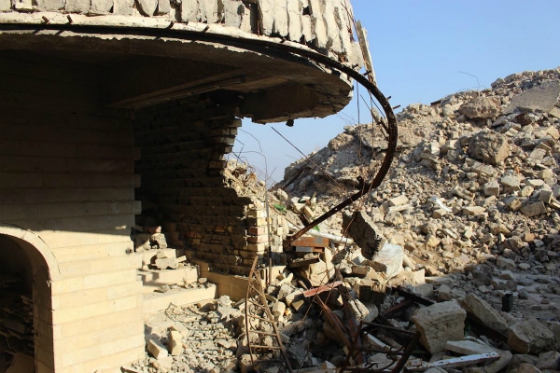Mosul’s wrecked roads, bridges and broader economy will take at least five years to repair and need billions of dollars of development that Iraq’s government says that it will struggle to afford despite massive oil wealth, officials returning to the battle-scarred city said.
The airport, railway station and university were all destroyed in the long fight to dislodge Daesh militants from their main Iraqi stronghold.
Iraqi government forces backed by a US-led coalition have now retaken the eastern half of the city – letting regional councillors return for the first time in two-and-a-half years to survey the damage.
“After Mosul is fully liberated, we need a working plan to restore things to the way they were before 2014 when Daesh took over,” Noureldin Qablan, deputy chairman of the council covering the surrounding Ninawa province, told Reuters.
He sat back in his office in the heart of Mosul, the province’s regional capital, an unremarkable building apart from its new concrete fortifications and the teams of armed guards surrounding it.
Reuters reported that a gun lay on his desk, next to his phone and piles of paperwork.
Outside, bustling markets have sprung back into life on the eastern banks of the Tigris river. Over on the other side of the river, Daesh fighters are holed in, defending the densely-populated Old City with snipers and suicide bombers.
At the heart of their territory sits the medieval Grand Al-Nuri Mosque and its famous leaning minaret, where Daesh leader Abu Bakr Al-Baghdadi declared his caliphate in July 2014. Experts fear the fragile brick structure could still succumb to the fighting raging around it, a terrible blow to Iraq’s storied Arab-Islamic history.
Iraq’s army has said it expects to expel Daesh from the rest of the city by the end of May.
‘We are not getting enough support’
The 34 Ninawa councillors, who have been meeting in other cities during the occupation, have already started drawing up plans to rebuild Mosul, though they are still were not sure where the money will come from, Qablan told Reuters.
For the first six months, local authorities would focus on restoring security, water, electricity and fuel, and on the return of those displaced by the war.
Under the plan, there would then be a two-year period of reconstruction and the initiation of a reconciliation process followed by 30 months focused on attracting investment and developing the economy.
Some of the early repair work could cost as little as $5,000 a house, Qablan said.
But even that would strain budgets that he said were under-funded by the central government in Baghdad.
“In 2013 we were allocated 738 billion dinars, yet after all this destruction we get just 52. It is very hard to reach our goals with this sum, so we are counting on foreign grants,” Qablan said.
Council officials are in talks with the United Nations, international aid groups and friendly states, he said. Italy was already helping rebuild a hospital.
Outside on the eastern side of the river, foreign investment was already flowing back in, in the form of market stalls heaving with Turkish and Iranian fruit and vegetables, replacing the less plentiful Syrian produce that had dominated under Daesh.
However, rebuilding the shattered cities left in the wake of the Iraqi government’s war against Daesh will likely create new political problems. Baghdad has been reticent to provide funding for Sunni Arab-dominated cities in the past, and there is little suggestion that the Shia-led regime is likely to change that stance any time soon.
Middle East Monitor
May 05
























































